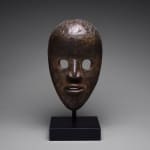Dan Wooden Gunye Ge or Zapkei Ge Mask, 20th Century CE
Wood
height 26 cm
height 10 1/4 in
height 10 1/4 in
PF.6373
Further images
The Dan are a farming people who inhabit the hinterland of the western Ivory Coast and Liberia. They have a great number of masked figures that represent spirits of the...
The Dan are a farming people who inhabit the hinterland of the western Ivory Coast and Liberia. They have a great number of masked figures that represent spirits of the bush, and fulfill a variety of social, political, and religious functions. Although eleven individual types of masks can be distinguished by formal criteria, the types cannot be associated with specific functions because the meaning of the masks change over time.
The rounded features and delicate carving characteristic of Dan masks make them among the most popular and highly appreciated types of all African art. The oval shape of the mask with its finely carved features including the high forehead and strongly protruding mouth with pursed lips indicates that this is probably the work of the northern Dan peoples. The circular eyes that permit unhindered vision on the part of the wearer are characteristic of the racer mask (gunye ge) and the fire mask (zakpei ge), two mask types originating in the north. The gunye ge hold weekly running contests during the dry season to test the prowess of young warriors. The zapkei ge also appear at this time of the year to inspect cooking fires and prevent possible spreading. A fibrous wig and beard would have originally filled the holes around the rim of the mask. This wig would have covered up the scarf that the wearer had to wrap around his head as a rule to further conceal the dancer’s identity. This mask is evocative but not imitative of the human form and originally served a sacred ceremonial purpose. All these aspects make the mask an epitome of African art that can be easily embraced and lauded by Western aesthetic tastes.
The rounded features and delicate carving characteristic of Dan masks make them among the most popular and highly appreciated types of all African art. The oval shape of the mask with its finely carved features including the high forehead and strongly protruding mouth with pursed lips indicates that this is probably the work of the northern Dan peoples. The circular eyes that permit unhindered vision on the part of the wearer are characteristic of the racer mask (gunye ge) and the fire mask (zakpei ge), two mask types originating in the north. The gunye ge hold weekly running contests during the dry season to test the prowess of young warriors. The zapkei ge also appear at this time of the year to inspect cooking fires and prevent possible spreading. A fibrous wig and beard would have originally filled the holes around the rim of the mask. This wig would have covered up the scarf that the wearer had to wrap around his head as a rule to further conceal the dancer’s identity. This mask is evocative but not imitative of the human form and originally served a sacred ceremonial purpose. All these aspects make the mask an epitome of African art that can be easily embraced and lauded by Western aesthetic tastes.







